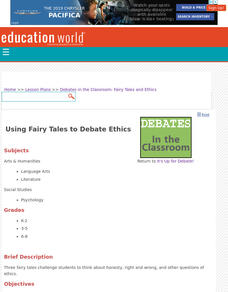Curated OER
Northwest Coast Indian Lesson Plan
Students create traditional hats. In this visual arts lesson, students design and create traditional hats that highlight animal features, line design, and geometric shapes in the style of the Kwakiutl.
Curated OER
Vocabulary Lesson: Money
In this mathematical vocabulary worksheet, students read the definitions of 15 monetary terms. There are no questions included on this worksheet.
Curated OER
A Different Point of View
Elementary schoolers utilize a pattern worksheet embedded in this plan to work on a deeper understanding of geometric concepts like symmetry and congruency. Since geometry is such a visual form of mathematics, this lesson should fit...
PBS
Patterns to the Rescue!
Track down the Cyberchase episode that this lesson is associated with. Using a worksheet that is embedded in the plan, learners must find the next two numbers and shapes (a double pattern). Once these have been discovered, pupils try...
Curated OER
Flying the Friendly Skies
Students discover the power of wind by flying a glider. In this weather lesson, students describe their thoughts on wind and practice using weather related vocabulary. Students construct model gliders in class and attempt to fly them...
Curated OER
Rob & Steal
In this action verb worksheet, students choose the appropriate action verb in ten sentences to make each one grammatically correct.
Curated OER
Spice Up Physical Education During the School Day!
Although kids love Steal the Bacon and Kickball, isn’t it time for something new?
Curated OER
The War of the Words
“Who’s This Guy Dylan Who’s Borrowing Lines From Henry Timrod?” The basic question in this lesson from the New York Time’s Learning Network is whether artists and authors who use the words of others are stealing from that artist or...
Curated OER
Writing History: From Students to Scholars
An Online NewsHour article about scholarly ethics launches this study of plagiarism. Since historians are supposed to bring original ideas and perspectives to their publications, they must give credit to the ideas of others. After a...
Curated OER
Lab 2: Drag Racing
In this activity, students, Analyze the relationship between velocity and acceleration * Calculate an object's average acceleration * Collect data and interpret it* Create and analyze a graph showing acceleration.Students also work in...
Curated OER
Quarter Rest Lesson
First graders indicate the silent beats (rests) with an outward motion of the arms. They indicate a measure clapped out with a quarter rest, and a measure clapped out without a quarter rest.
Curated OER
Tackling Race Issues on the Field
Students explore what it means to be 'in the minority.' students experience what it feels to be treated differently by peers in which they are 'labeled' with statements that determine how others in their groups relate to them.
Curated OER
What is Plagiarism?
What is plagiarism? Middle schoolers create a class definition of plagiarism and examine the importance of crediting people for their ideas. They review official school policy on plagiarism and study the consequences of presenting the...
Curated OER
Stealing Home: Chavez Ravine
Students research the Chavez Ravine community of Los Angeles and the displacement of residents for the construction of Dodger Stadium. They discuss Chavez Ravine in terms of property rights versus eminent domain.
Curated OER
Celebrations: Hanukkah
Connect reading comprehension strategies with the traditions of Hanukkah with an informative lesson plan. As learners read about the history of Hanukkah, the significance of the menorah, and the ways Hanukkah is celebrated today, they...
Curated OER
Physical Education: Mission Possible
Students participate in a physical education activity, Mission Possible, where they attempt to steal a jug of jewels. They must successfully overcome five challenge areas to complete the activity. Students develop cooperative...
Curated OER
Plagiarism
Don't get caught plagiarizing! Before starting your research unit, use this lesson to help your young writers identify plagiarism. The truth is, many kids don't even realize when they're doing it! They practice citing sources when...
Curated OER
Using Fairy Tales to Debate Ethics
Is trickery ever justified? Is it okay to steal from someone who has stolen from you? Puss, from Puss in Boots, and Jack, from Jack and the Beanstalk, might have some ideas about these ethical questions. After listening to a series of...
American Museum of Natural History
Wonderful World of Wasps
Shockingly, wasps sometimes challenge lions as the king of predators! Learners explore the life of a wasp in an interactive online lesson. They read about the characteristics of wasps and then complete activities to learn about their lives.
Curated OER
Invaders and Settlers: The Vikings
Introduce your young historians to the amazing Vikings! This presentation provides information on the culture, travels, rule, religion, and tools used by the Vikings. After each 3-5 slide section are slides containing compression...
American Museum of Natural History
What's This? Reproduction
Attracting the right mate is as important for humans as any other species. An interesting lesson teaches individuals about several strategies that animals and plants have adapted to attract their mates. From colorful nests to powerful...
Curated OER
Crimes from Mother Goose
Students use Nursery rhymes in a discussion of crimes and criminals in order to study how criminal law has developed and changed to maintain an organized society. They decide on the identity of criminals, the crime, and the name of the...
Curated OER
Elections - Mobilization Versus Suppression
Students analyze voter suppression. In this voting practices lesson plan, students listen to their instructor present a lecture comparing voter suppression and voter mobilization. Students respond to the provided discussion questions.
Curated OER
Giving an Outdoor Plan
Students utilize their acting skills to put on an impromptu play based on a book. In this performance art lesson, students read Caps for Sale by Esphyr Slobodkina and discuss how the story could be told through human action. Students...

























